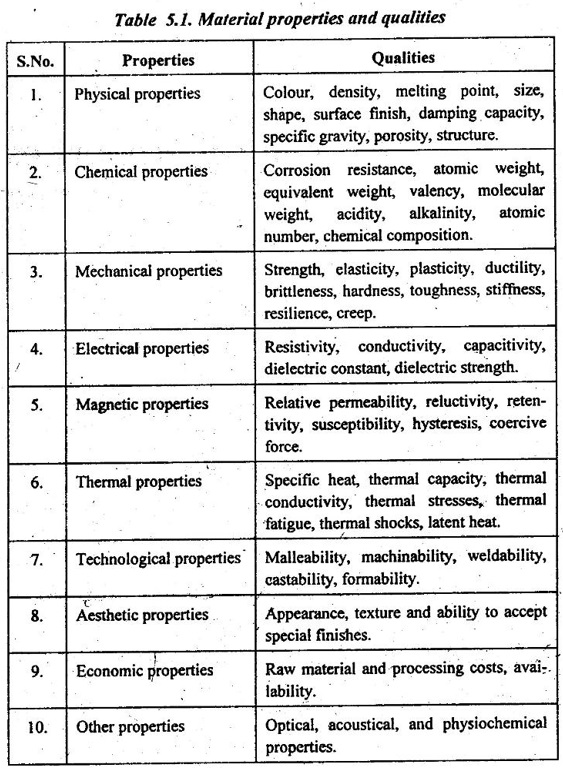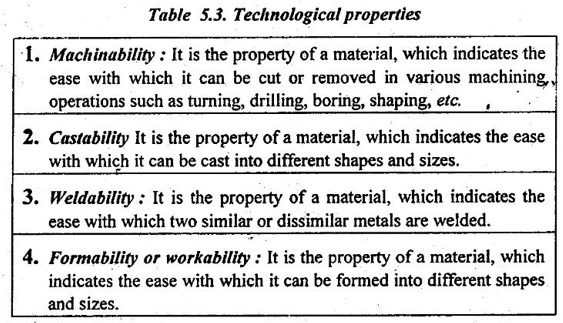There are many thousands of different engineering materials available today.
UNIT - 5
Mechanical Properties And Testing
“One good test is worth a thousand expert opinions."
-Anonymous
"Theory is the captain; Practice, the soldiers."
- Leonardo Da Vinci
MECHANICAL PROPERTIES OF MATERIALS
1. PROPERTIES OF ENGINEERING MATERIALS
✔ There are many thousands of different engineering materials available today. But they can be placed into one or other of the following categories:
1. Metals,
2. Polymers,
3. Ceramics and inorganic glasses, and
4. Composites.
✔ All materials exhibit many different properties and qualities. The properties of material provide a basic for predicting its behaviour under various conditions.
✔ An engineer must have wide knowledge of materials and their properties so that he may select a suitable material for his product.
✔ Some of the most important properties of materials are grouped as shown in Table 5.1.

However, our scope here is limited to the study of the mechanical and technological properties of metals.
1. Mechanical Properties
✔ Mechanical properties are those characteristics of material that describe its behaviour under the action of external forces.
✔ A sound knowledge of mechanical properties is very essential for an engineer to select a suitable material for his various design purposes.
✔ Though there are many mechanical properties of a metal, some of the most important mechanical properties are summarised in Table 5.2.

Table 5.2. Mechanical properties
1. Elasticity:
✓ It is the property of a material by virtue of which it is able to retain its original shape and size after the removal of the load.
✓ Examples: Steel and rubber.
✓ This property is desirable in materials used in tools and machines.
2. Plasticity:
✓ It is the property of a material by virtue of which a permanent deformation (without fracture) takes place, whenever it is subjected to the action of external forces.
✓ Examples: Clay and lead.
✓ This property is of importance in forming, shaping and extruding operations.
3. Ductility:
✓ It is the property of a material by virtue of which it can be drawn into wires before rupture takes place.
✓ Ductility of material can be measured by the percentage of elongation and the percentage of reduction of area before rupture."
✓ Examples: Gold, platinum, silver, iron, copper, and aluminium.
✓ A knowledge of this property is important during fabrication operations.
4. Malleability:
✓ It is the property of a material by virtue of which it can withstand deformation under compression without rupture.
✓ Examples: Gold and lead.
✓ This property is of importance in forging and rolling operations.
5. Brittleness:
✓ It is the property of a material by virtue of which it will fracture without any appreciable deformation.
✓ Examples: Cast iron and glass.
✓ This property is desirable in machine parts which may be subjected to sudden loads.
6. Hardness:
✓ It is the property of a material by virtue of which it is able to resist abrasion, indentation (or penetration), machining, and scratching.
✓ It is measured by the resistance of the material it offers to scratching.
✓ Examples: Diamond, quartz, and glass.
7. Toughness:
✓ It is the property of a material by virtue of which it can absorb maximum energy before fracture takes place.
✓ It is measured by the tenacity and hardness of the material.
✓ Examples: Mild steel, brass, and wrought iron.
8. Stiffness:
✓ It is the property of a material by virtue of which it resists deformation.
✓ Modulus of elasticity (i.e., ratio of stress to the strain below elastic limit) is a measure of stiffness of a material.
9. Resilience:
✓ It is the property of a material by virtue of which it stores energy and resists shocks or impacts.
✓ It is measured by the amount of energy that can be stored per unit volume after being stressed to elastic limit.
✓ This property is desirable in materials used for springs.
✓ The maximum energy which can be stored in a body upto the elastic limit is called the proof resilience, and the proof resilience per unit volume is called the modulus of resilience.
10. Creep:
✓ It is the property of a material by virtue of which it deforms continuously under a steady load.
✓ This property is considered in designing I.C. engines, boilers, turbines, etc.
11. Endurance:
✓ It is the property of a material by virtue of which it can withstand varying stresses.
✓ The maximum value of stress that can be applied for an indefinite times without causing its failure is known as endurance limit.
✓ This property is desirable in the design and production of parts subjected to vibrations.
12. Strength:
✓ It is the property of a material by virtue of which it can withstand or support an external force or load without rupture.
✓ This property is very important while designing various structures and components.
(a) Elastic strength: It is the value of load corresponding to transition from elastic to plastic range.
(b) Plastic strength: It is the value of load corresponding to plastic range and rupture.
13. Impact strength: It is the property of a material by virtue of which it can resist or absorb shock energy before it fractures.
14. Fatigue: It is the property of a material by virtue of which it deforms under the fluctuating or repeated loads.
2. Technological Properties
✓ Technological properties are those which have a bearing on the processing and/or application of materials.
✓ These properties are highly desirable qualities in the shaping, forming, and fabrication of materials for useful properties.
✓ Some of the most important technological properties are summarised in Table 5.3.

Table 5.3. Technological properties
1. Machinability: It is the property of a material, which indicates the ease with which it can be cut or removed in various machining, operations such as turning, drilling, boring, shaping, etc.
2. Castability: It is the property of a material, which indicates the ease with which it can be cast into different shapes and sizes.
3. Weldability: It is the property of a material, which indicates the ease with which two similar or dissimilar metals are welded.
4. Formability or workability: It is the property of a material, which indicates the ease with which it can be formed into different shapes and sizes.
3. What are the Factors Affecting Mechanical Properties?
Though there are number of factors affect mechanical properties, the following factors highly influence the mechanical properties :
1. Grain size,
2. Heat treatment,
3. Atmospheric exposure, and
4. Low and high temperatures.
1. Effect of Grain Size
✔ Since metals are composed of grains, therefore grain size has important effect on the mechanical properties of material.
✔ The materials having smaller grains (i.e., fine grained structure) have high yield strength, high tensile strength, and more hardness. Also fine grain results in better resistance to cracking and better surface finish.
✔ The materials having larger grains (i.e., coarse grained structure), exhibit better workability, hardenability, forgeability and creep resistance. But coarse grains result in poor surface finish, less tough and have greater tendency to cause distortion.
2. Effect of Heat Treatment
✔ Since the heat treatment changes and/or refines the grain size, therefore the mechanical properties are affected.
✔ The heat treatment improves mechanical properties like tensile strength, toughness, hardness, ductility, shock resistance and resistance to corrosion.
✔ It also improves workability, forgeability and machinability of metals.
3. Effect of Atmospheric Exposure
✔ The effect of atmospheric exposure on metals is indicated by a scale formation or by a corrosion.
✔ Scale or film formation is due to oxidising action of air on the metal surface while corrosion or film breakdown is due to electrochemical action.
4. Effect of Low and High Temperatures
✔ The temperature of a material greatly affects its mechanical properties.
✔ Low temperature metals increase the creep resistance, and tensile and yield strengths; but decrease the toughness and ductility.
✔ On the other hand, high temperature metals decrease tensile and yield strengths; but increase the toughness and ductility.
No comments:
Post a Comment